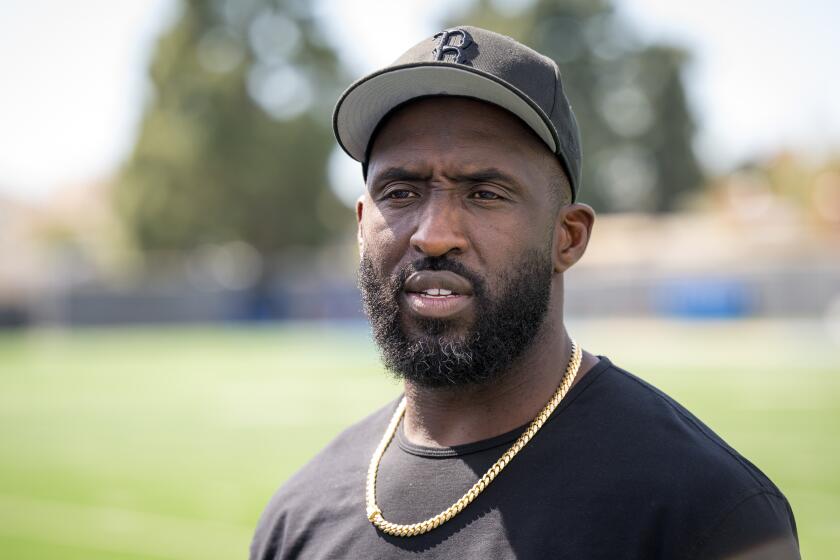UCLA season goes to seed
- Share via
A few of the UCLA players, the seniors, remember what it feels like.
Heading into the NCAA tournament as something less than a highly seeded team. Wondering how far they might travel for their first-round game and what kind of draw they might get.
As for the rest of the team, this is unknown territory.
A program that has entered the last three tournaments seeded first or second -- and reached the Final Four each time -- is looking at a bumpier road this season in the wake of a string of costly defeats.
“We know we messed up,” swingman Josh Shipp said, adding: “It’s out of our control now.”
Well, not exactly. Over the next two weeks -- starting with tonight’s game against Oregon State at Pauley Pavilion -- 20th-ranked UCLA has a shot at jumping a few spots on the March Madness food chain.
Jerry Palm, a columnist for CBSSports.com who has spent most of his adult life pondering such matters, currently projects UCLA at No. 6 in the East Region, opening against 11th-seeded Florida in Miami, though the projections could change at any moment.
“It’s a team that I’ve felt pretty much all year has been overrated compared to their accomplishments,” Palm said of the Bruins.
So how can they better their position?
Start with some bracket defense. UCLA cannot afford to lose to either of the Oregon schools -- the Beavers and Ducks inhabit the lower half of the Pacific 10 Conference standings -- at home this week.
“Those are high-risk, no-reward games,” Palm said.
And forget about the conference title. The Bruins can tie Washington for the regular-season championship with two wins and a Huskies loss to Washington State, but that piece of hardware probably won’t sway the NCAA selection committee.
The real opportunity to impress comes next week during the Pac-10 tournament at Staples Center. Even in a down year for the conference, UCLA could parlay victories over No. 16 Washington and/or No. 21 Arizona State into a third or fourth seeding.
And that could make a difference.
Consider the historical data. Fifth-seeded teams lose their first-round games against 12th-seeded teams about 32% of the time, even more often in recent seasons.
Jump up one spot -- No. 4 vs. No. 13 -- and the upset factor drops to about 20%.
Third-seeded teams are even safer, losing only 17% of the time. As Palm explained: “You want to be a four or better.”
The math doesn’t fully convince UCLA guard Darren Collison.
“The teams we play against, they’re not going to say ‘Well, they’re a three seed so we’re just going to back down . . .” he said. “No, they’re going to go out and try to take it to us.”
Fair enough, but there is a part of the seeding process that even Collison respects: The higher the seeding, the more likely the team will play its early games close to home.
In the 2006 and 2007 tournaments, the Bruins played all of their games leading to the Final Four in California. Last year, they started in Anaheim, then took a short hop to Phoenix for the regionals.
This time, they don’t figure to be as lucky.
While Palm has them in Kansas City, Joe Lunardi of ESPN’s “Bracketology” projects them as the East Region’s No. 5, starting against 12th-seeded Miami in Boise, Idaho. Another northern site -- Portland, Ore. -- is possible.
“We’d rather play in Portland as opposed to Minnesota or any of those East Coast areas,” Collison said. “It’s just traveling. A lot of traveling results in fatigue and jet lag.”
A No. 3 seeding probably would guarantee West Coast games. A No. 4 creates further complications.
The NCAA tries to keep teams as close to home as possible, cutting down on expenses and making it easier for fans. But if the Big East sends eight or more teams to the tournament, as some predict, the selection committee will spread them across various brackets to avoid a conference rematch in the early rounds.
That could mean sending a few Eastern schools out West and bumping Western schools in the opposite direction.
“What happens in the Big Ten, what happens in the ACC and the Big East” affects UCLA, Palm said. “The further they go down the seed list, the less flexibility.”
Such permutations don’t seem to bother older players such as Shipp or Collison, though they recall the 2005 tournament when 18-10 UCLA entered as a No. 11 and lost to sixth-seeded Texas Tech in a first-round game in Tucson.
Still, Shipp said, “If we get shipped back East somewhere, doesn’t matter. We’ve still got to go out there and win games.”
--
--
UCLA tonight
VS. OREGON STATE
Time: 7:30.
On the air: TV: Prime Ticket; Radio: 570.
Where: Pauley Pavilion
Records: UCLA 22-7, 11-5 Pac-10; Oregon State 13-14, 7-9.
Update: The 20th-ranked Bruins’ final homestand of the season begins with surprising Oregon State. How to explain the Beavers’ turnaround from last season’s 0-18 conference record? First-year Coach Craig Robinson gets most of the credit, with an assist from guard Calvin Haynes -- formerly of Woodland Hills Taft High -- and his 15.5 points a game. “He’s shorter than me, but he’s really fast, really athletic,” said UCLA guard Jrue Holiday, who figures to defend him. Another Bruins freshman guard, Malcolm Lee, should be recovered from a mildly sprained ankle.
-- David Wharton
--
UCLA
up next
TONIGHT VS. OREGON ST.
at Pauley, 7:30, Prime
--
SATURDAY VS. OREGON
at Pauley, 12:30 p.m., Ch. 7
--
USC
up next
TONIGHT VS. OREGON
at Galen, 7:30, no TV
--
SATURDAY VS. OREGON ST.
at Galen, 5 p.m., no TV
More to Read
Go beyond the scoreboard
Get the latest on L.A.'s teams in the daily Sports Report newsletter.
You may occasionally receive promotional content from the Los Angeles Times.







